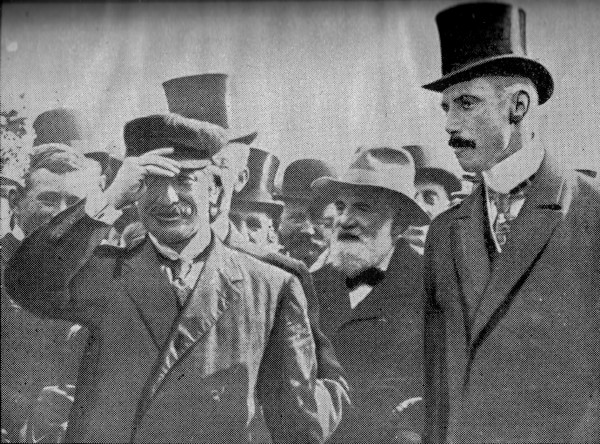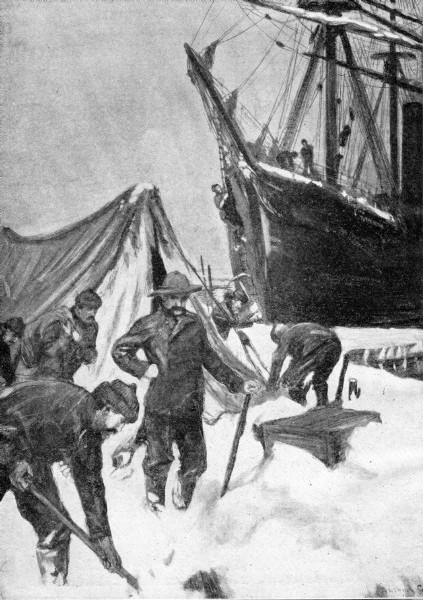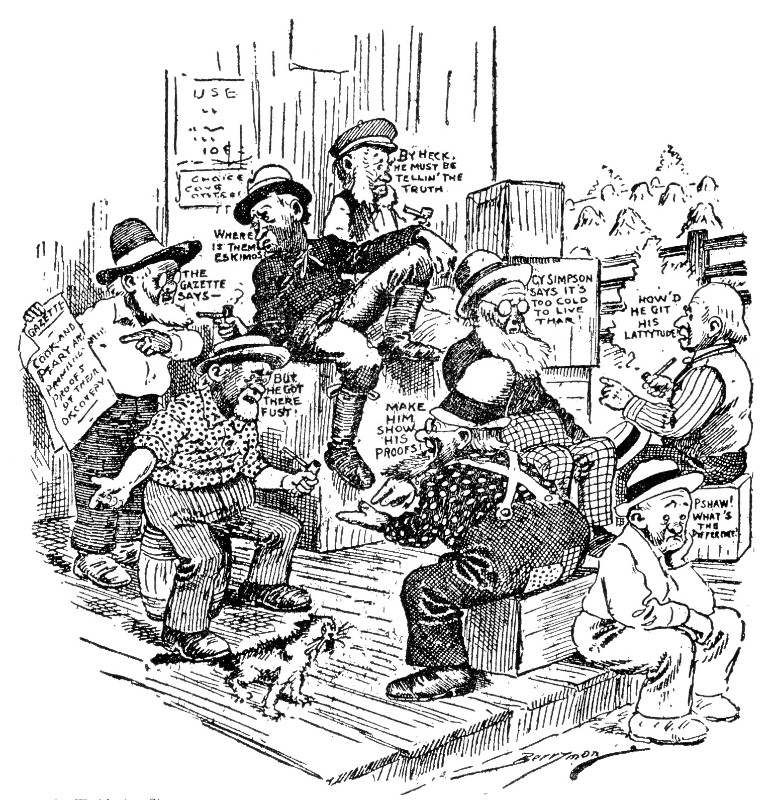| Web
and Book design,
Copyright, Kellscraft Studio 1999-2011 (Return to Web Text-ures) |
 (HOME)
|
| CHAPTER VIII.
PEARY'S SUCCESSFUL VOYAGE. The start of Commander Peary's victorious journey to the pole was far different from that of Dr. Cook. The latter kept his plans secret from all but a few intimates; his ship went north in the guise of a hunting expedition. Peary, on the other hand, set sail with acclaim of crowds and the Godspeed of hosts of friends. Furthermore, he received the enthusiastic best wishes of Theodore Roosevelt, then president, after whom Peary's vessel was named. Peary and his party left New York July 6, 1908. Forty guests of the Peary Arctic Club, along with Commander and Mrs. Peary, accompanied the steamer to City Island and returned to the city later on the navy tug Narkeeta. Commander and Mrs. Peary and Herbert L. Bridgman, secretary and treasurer of the Arctic Club, left later for Oyster Bay to have luncheon with President and Mrs. Roosevelt. President and Mrs. Roosevelt inspected the vessel and Capt. Bartlett continued upon his long journey, heading for Sydney, Cape Breton. The crowd that lined the pier cheered Peary enthusiastically as the boat left New York. Peary took off his hat and waved a handkerchief in acknowledgment. Most of the guests had gotten there ahead of him. Gen. Thomas H. Hubbard, president of the Arctic Club, and Mr. Bridgman were in charge. Among those present were: John W. Flagler, Anton Raven, Henry Parish, Mr. and Mrs. William Guggenheim, Arva B. Johnson, president of the Philadelphia Arctic Club; Dr. Theodore Le Boutillier, secretary of the Philadelphia Arctic Club; Mr. and Mrs. Robert Guggenheim, and C. K. G. Billings. Just before sailing Peary went below to see that all the gifts he was taking to the Eskimos were safely aboard. Money does not look good to those in the far north and it takes looking glasses, silver thimbles, shot guns and things like that in the way of presents to coax them along. Likewise Peary dropped in to see if Dave Henson, the negro cook, was in his proper place. Dave has been with him on each trip. His work was to boss the Eskimo drivers and hunters. Dave speaks their native tongue with ease. The Roosevelt left its landing at the foot of East Twenty-fourth street on the minute. It was pushed into the river by the Narkeeta, and such a din as went up hasn't been heard in those parts for some time. A hearty-looking ferryboat started the fun by tooting a regular salute of three short blasts. This was taken up with a vim by a dozen yachts of the New York Yacht Club. Then came the din of the crowd on the recreation pier, yelling itself hoarse to the accompaniment of the whistles of numerous factories along the river shores. Capt. Bartlett at first tried to acknowledge all the salutes, but they came so fast that before proceeding with his task he ordered a chair and made himself comfortable on deck with an improvised rope up to the whistle. He tooted until the steam gave out and it was up to the Narkeeta to answer for awhile, and the navy folks certainly did the thing up in style. No craft was too little or too big or too squeaky to get a speedy acknowledgment. Possibly the greatest reception the little ship got was from the Mayflower, the president's yacht, which was anchored off Whitestone, Long Island. The ship was manned in a hurry, and after a salute was tooted the jackies set up a cheer that brought Peary from the lower deck in a hurry. He doffed his hat and waved his handkerchief like a good fellow, and was tickled clear down to his shoes. To cap the climax, the Mayflower's occupants slowly dipped the American flag aft. Peary himself answered this by dropping his flag in the same fashion. The incident stirred his navy blood and the veteran skipper danced around like a boy. .The Roosevelt left Sydney, N. S., July 26. It was next reported at Domino, Labrador, July 29, from which point it crossed to Greenland. It passed Cape York August 7, 1905, and reached Etah August 16 of that year. The expedition's auxiliary steamer Erik, in the meantime, had visited various settlements in Greenland and secured natives and dogs for the explorer and turned them over to the Roosevelt. At Etah the Roosevelt overhauled its machinery, took on board the last supply of coal from the Erik and thence proceeded north with Eskimos to the number of twenty-three on board and about 200 dogs. Peary's start from Etah on the second stage of his journey into the far north in search of the pole was described in a letter received in New York October 8, 1908, from Capt. Samuel W. Bartlett. The letter was written by Capt. Bartlett on his arrival at St. John's, N. F., after carrying supplies to the Peary expedition in the steamer Erik. Capt. Bartlett said the weather conditions at Etah were anything but pleasant. It had been an unusually wet and foggy summer and Peary's departure north in the Roosevelt was delayed twenty-four hours because of dense fog and high winds. It had been planned to start on August 17, but it was the 18th before the steamer got away. The fog was still dense, but Capt. Bartlett said he was sure the Roosevelt had a good trip up Smith Sound, as the prevailing winds were south, which would pack the ice over on the Greenland side. Nothing was seen of the Roosevelt after it left Etah harbor. Commander Peary's own story of his preparations for his dash toward the North Pole, dated Etah, Greenland, September 20, 1908, follows: "Here we are at Etah, the Roosevelt stripped and sponged for the second round. As when the Roosevelt headed away across the gulf of Maine from Pollock Reef lightship, so now, on heading due north from Sydney harbor, the weather was of the finest. "Here the little tug which had accompanied us thus far swung off and turned back, carrying Mrs. Peary and the children, and Borup's father with two or three friends. "Throughout the night we steamed steadily northward across Cabot Strait with Polaris shining directly over the fore topmast. This in striking contrast to three years ago, when we crossed the straits in dense fog to the accompaniment of a long swell which kept the main deck constantly awash. In the forenoon we passed Cape Ray, and in the afternoon the magnificent headland Cape St. George. "Early the day following we entered the harbor of Cape St. Charles and dropped anchor in front of the whaling station just as the costal steamer Prospero passed out with numbers of tourists on board. "Two whales captured the day before offered opportunity for securing some whale meat without delay, and I immediately engaged one, which was at once hauled out on ^he slide, while Bartlett, with Marvin, McMillan, and Borup, took one of the whaleboats and pulled across to Battle harbor, some five miles distant, to learn what was the outlook for whale meat at Hawke's harbor by wireless. "About noon Bartlett and the boys returned with news of abundance of whale meat at Hawke's harbor, the supply engaged here amounting to about 18,000 pounds. It came late in the afternoon and was hoisted on the quarter deck between the coal bags and the after end of the deck house. This done, we steamed out, and with the big lugsail set to a following breeze and the engines just barely turning over, we drifted down the coast toward 'Hawke's harbor, so as to arrive early in the morning. "We had expected to run direct for the Greenland coast from here, but a consignment of Labrador skin boots which were to have been at Hawke's harbor were not here, and I determined to follow the coast to Turnavik land, where they were. "In a continuance of fine weather we came in sight of Turnavik late in the afternoon of the following day. Before reaching the island, however, we encountered a furious thunder storm, and finally dropped anchor amid a half gale. At the island ice was reported a few miles outside, and this, with the darkness and the -force of the wind, resulted in our lying at Turnavik until the next morning. "The weather now for the first time was distinctly dirty, wind, rain, fog and seething of a sea. All these, however, moderated in the afternoon. In the evening it came off entirely clear, and for some three hours we passed through a stream of scattered, waterworn and rotten ice. After this the weather continued fine, with light, favoring westerly winds until Saturday evening. "Saturday night we ran into fog, and for the first time encountered an uncompromising head wind, which continued with distinct violence until late Monday and then with less force throughout Tuesday. "During a portion of this time there was a pronounced sea running, and for the first time the Roosevelt had the experience of driving dead on through a head sea. No ship could make rapid progress under these conditions (our log from noon Monday to noon Wednesday was eight-four miles), but in every other way the Roosevelt proved satisfactory in this test as in others which she has encountered. She rises easily, meets and parts the waves readily and recovers from a lunge buoyantly and without shock. Of course her length is an important factor in this. I could not help thinking how uncomfortable the poor little, stumpy Fram would be under similar circumstances. "Following is a complete roster of those who are with me on board the Roosevelt: "John W. Goodsell, surgeon of the expedition, was born of native Pennsylvanians at Leechburg, Pa., January 19, 1873. He is 35 years of age, unmarried, 5 feet 10 inches in height, and weighs 200 pounds. In addition to his work as a general practitioner, Dr. Goodsell built up a considerable practice as a consulting microscopist. Dr. Goodsell expects to make a special investigation of tubercular conditions among the natives and the curative effects of the Arctic atmosphere. "Prof. Ross G. Marvin of the college of civil engineering, Cornell University, is on leave of absence from that institution in order to complete the work begun on the previous expedition of 1905-'06. Prof. Marvin is 28 years of age, 5 feet 11 inches in height, and weighs 160 pounds. He received the degree of A. B. from Cornell University in June, 1905, and immediately upon graduation was chosen as my secretary and assistant for the expedition of 1905-'06.  DR. COOK'S ARRIVAL FROM NORTH POLE. Dr.
Cook is the man on the left, with a pleasant grin and his hand to his
cap, just as he left the launch which brought him from the ship. Mr.
Stead, the veteran journalist, is the man with the soft hat in the
center of the group. The man towering above the crowd on the right of
the photograph is the representative of royalty, the Crown Prince of
Denmark, who went to the wharf to give Dr. Cook a hearty welcome and
congratulate him on his successful exploration trip.
 PEARY'S PARTY PREPARING WINTER QUARTERS IN THE ARCTIC REGIONS. "Donald B. McMillan, an assistant in the expedition party, was born in Provincetown, Mass., November 10, 1874. He is 33 years of age, unmarried, 5 feet 9 inches in height, and weighs 165 pounds. He comes from a family of seafaring people. "George Borup, an assistant in the expedition party, was born at Sing Sing, N. Y., September 2, 1885, a son of Lieut. Col. Borup, U, S. A., retired. He is 23 years of age, 5 feet 8 inches in height and weighs 155 pounds. "Matthew Henson, Commander Peary's personal assistant, was born of negro parentage at Washington, D. C, August 8, 1867. He is 41 years of age, 5 feet 10 inches in height, and weighs 150 pounds. "Charles Percy, steward of the Roosevelt, is one of the men who have been with her since she was built. Born of native parentage at Brigus, N. F., September 15, 1850, he is now 58 years old, 5 feet 11 inches tall. "Capt. Robert A. Bartlett, sailing master and ice navigator of the Roosevelt, was born at Brigus, Conception Bay, near St. John's, N. F., August 15, 1875. Thirty-three years of age, 6 feet tall and weighing 170 pounds, he is the ideal type of the hardy Newfoundland sealer and fisherman. His great-uncle, Capt. Isaac, rescued the Tyson party from an ice floe after their perilous drift of many months. His uncles, Capt. Harry, Capt. John, and Capt. Sam, have all made trips into the Arctic at various times in command of ships. "His father, Capt. William Bartlett, is a successful sealer and fisherman with a thriving fishing station at Turnavik island, on the Labrador coast. "Bank Scott, second engineer of the Roosevelt, is the second new officer aboard the Roosevelt. He was born at St. John's, N. F., July 4, 1880, 28 years of age, 5 feet 9 inches in height, and weighs 150 pounds. "Other members of the crew are Seamen John Barnes, John Cody, and Dennis Murphy; Oilers John Bentley and Patrick Joyce; Firemen Richard Butler, George Percy, Patrick Skeans, and John Wiseman, and William Pritchard, mess boy. "Thomas Gushue, mate of the Roosevelt, is a new officer aboard the ship. Born of native parents at Brigus, Conception bay, Newfoundland, November 3, 1861, he is 47 years of age and 5 feet 10 inches in height. His sea service covers about thirty years. For the last fifteen years he has been master of various fishing schooners.  THE POLAR DISPUTE GETS VERY EXCITING. From the Washington Star "John Murphy, boatswain of the Roosevelt, was born of native parents at St. John's, N. F, He is 35 years of age, 6 feet tail, weighs 175 pounds and is married, having a wife at his home at St. John's. "George A. Wardell, chief engineer of the Roosevelt, was born of Yankee parents at Bucksport, Me., February 16, 1861. He is 47 years of age, 5 feet 11 inches tall, and weighs 240 pounds. He is married and has a wife and one son at his home in Bucksport. He learned his trade as a marine engineer in the shipyards where the Roosevelt was later constructed." Then came the last message, received by Peary's New York friends October 16, 1908. It said: "This is the last word I will be able to send forth for at least a year. "Before us lies the great ice pack stretching for a distance of 200 miles, and against its mighty force the sturdy little Roosevelt must set its prow. "By February 1 we expect to be in a position to make the dash for the pole." |